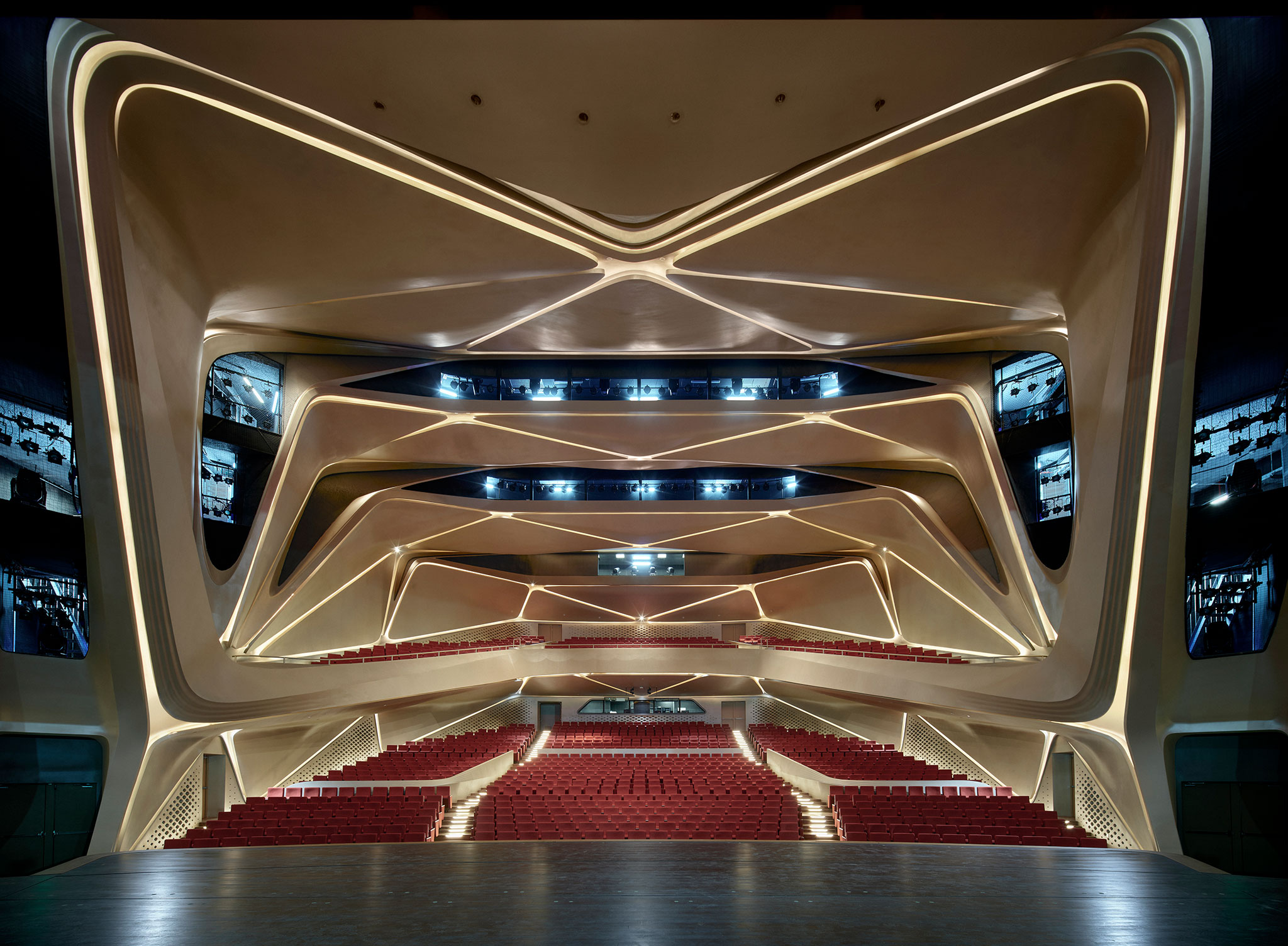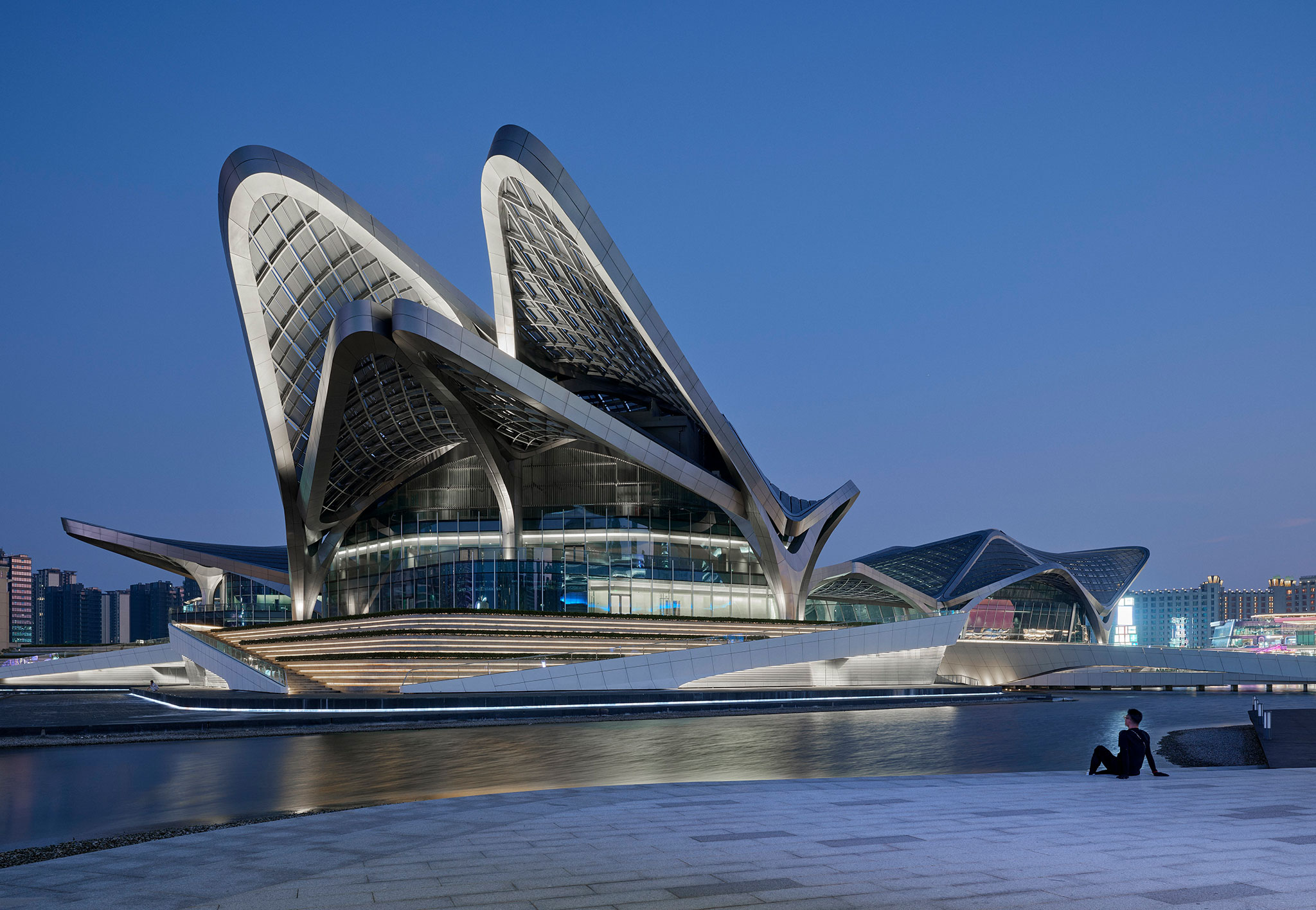The Grand Theater and Art Museum are finished in a range of light materials, while the multifunctional Black Box Theater and Science Center are composed of darker materials. The double-layer glazing, due to the subtropical climate, allows visitors to determine the individuality and character of each location.
The landscaping and the building itself are built following the idea of a "sponge city" in which the sustainability of the buildings is taken into account, reusing at least 70% of the city's rainwater, and using aquatic flora and fauna to filter contaminants naturally.

Zhuhai Jinwan Civic Art Centre by Zaha Hadid Architects. Photograph by CAT-OPTOGRAM STUDIO
Project description by Zaha Hadid Architects
Designed as a hub of contemporary creativity within one of the world’s most dynamic regions, the Zhuhai Jinwan Civic Art Centre is at the heart of Aviation New City, an urbanisation with a built area of 4.78 million sq. m housing 100,000 residents and incorporating new civic, cultural, academic and commercial infrastructure within Zhuhai’s Jinwan district. The Zhuhai Airport Railway, an extension of the Guangzhou- Zhuhai Intercity Railway, provides direct connections with Zhuhai’s city centre and its airport, while the new Hong Kong-Zhuhai- Macau bridge enables those in Shenzhen and Hong Kong to reach Zhuhai in less than an hour.
Integrating three distinct cultural institutions for the city (a Performing Arts Centre with a 1200-seat Grand Theatre and a 500-retractable-seat multifunctional Black Box theatre; an interactive Science Centre; and an Art Museum) each venue within the Zhuhai Jinwan Civic Arts Centre incorporates unique characteristics that create differing visitor experiences, yet all are united by a coherent formal and structural logic that spans 170 meters wide from east to west and 270 meters long from north to south.
Arranged symmetrically on a central axis, the two larger and two smaller venues are connected by a central plaza that serves as a shared external foyer for all of the cultural institutions. Glazed walls facing this courtyard enable visitors to determine the individuality and character of each venue. The Grand Theatre and Art Museum are finished in a light palate of materials, while the multifunctional Black Box Theatre and Science Centre are composed of darker materials.

Zhuhai Jinwan Civic Art Centre by Zaha Hadid Architects. Photograph by CAT-OPTOGRAM STUDIO.
Echoing the chevron patterns of migratory birds flying in formation over southern China, the latticed steel canopies sheltering each venue are configured through repetition, symmetry and scale variation; resulting in a composition of related elements that respond to the different functional requirements of each building. This repetition of the self-supporting and self-stabilising roof modules optimised pre-fabrication, pre-assembly and the use of modular construction.
The distinctive roof structure unites the different venues under a network of reticulated shells that envelop the four wings of the centre. Interconnecting bridges and voids create a multi-layered public plaza at the heart of the centre with views to the interiors as well as to the surrounding promenades with their cafés, restaurants and educational facilities. The design optimizes intuitive navigation with natural light in all public areas to enhance connectivity; creating engaging civic spaces for residents to enjoy throughout the day and evening.
The Grand Theatre’s interior continues the composition of the centre’s external roof canopy with the location and angle of ceiling panels optimised as sound reflectors. The Grand Theatre’s sound-absorbing surfaces are designed to meet the highest acoustic standards required for local, national and international performances.

Zhuhai Jinwan Civic Art Centre by Zaha Hadid Architects. Photograph by Virgile Simon Bertrand.
The Art Museum adapts the chevron geometries of the roof to frame the main atrium which provides natural light to the museum while at the same time creating a continuous vertical surface to display artworks. An internal gallery, storage and administrative spaces are located behind this vertical division. Merging architecture with an exhibition experience, a continuous white ‘ribbon’ of the museum’s vertical circulation and exhibition route is its’ defining feature.
The Science Centre’s interior also translates the geometry of the centre’s roof to showcase scientific innovation with interactive exhibits that inspire curiosity and learning. The Science Centre’s lecture hall is designed for the centre’s programme of public demonstrations of scientific experiments and discovery.
Zhuhai Jinwan Civic Art Centre’s podium defines an island within ZhongXin Lake. Pedestrian ramps and tunnels invite visitors to cross the lake’s surface to the podium’s central public plaza where footbridges connect through voids to each venue. Glazed façades sheltered by the modular roof canopy provide transparency and welcome the local community onto lakeside boardwalks and plazas beneath the sweeping roof structure. An external amphitheatre on the west side of the centre allows for outdoor performances and activities.

Zhuhai Jinwan Civic Art Centre by Zaha Hadid Architects. Photograph by Seilao Jiong.

Zhuhai Jinwan Civic Art Centre by Zaha Hadid Architects. Photograph by Virgile Simon Bertrand.
Constructed in concrete, the centre consists of five structurally separate buildings, each with its own self-supporting external steel canopy. Supported by only 22 columns and spanning a total of 270m x 170m, these free-formed steel roof canopies are composed of symmetrical geometries to enable their modular, repetitive structures to be fabricated off-site and assembled from only two different column types.
The centre’s landscaping and surrounding lake are designed as integral elements within Zhuhai’s ‘sponge city’ initiative that targets the natural permeation, storage and reuse of at least 70% of the city’s rainwater using aquatic flora and fauna to naturally filter contaminants. Humidity and soil-moisture sensors within the landscaping’s irrigation system control and reduce water consumption.

Zhuhai Jinwan Civic Art Centre by Zaha Hadid Architects. Photograph by Virgile Simon Bertrand.
Located within the subtropical climate of coastal southern China, the double-insulated glazing of the building’s envelope is optimized for thermal performance and protected by the latticed roof canopy which incorporates perforated aluminium panels for external solar shading. The perforations within the panels vary in size to allow differing degrees of sunlight within the centre’s interior spaces following their programming requirements, orientation and solar gain. At night, this roof canopy bathes the centre in soft reflected light.
Energy consumption and indoor air quality monitoring systems with intelligent control will automatically adjust the centre’s interior environments for optimal comfort and energy reduction. Waste heat recovery will be used to meet the centre’s hot water demand with water-saving appliances connected to the centre’s water recycling system. Designed to meet the highest tiers of China’s Green Building Evaluation Standards, the selection and procurement of the centre’s structural components has prioritized recycled steel, aggregates and other component materials.




































































